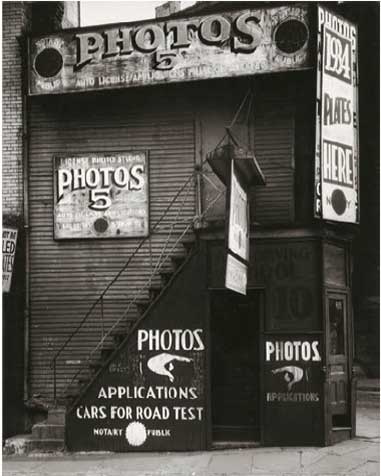
The Pompidou Center revisits the work of one of the 20th century’s most influential photographers with an extensive Walker Evans’ (1903-1975) retrospective. His signature style with its attention to quotidian detail became a major photography reference for serious students of photography. This is the first major retrospective of his work in France (until August 14, 2017).
The exhibition—curated by Clément Chéroux who recently became head of photography at SFMOMA— explains how the vernacular became for Evans both a subject and a method. For photography cognoscenti the word vernacular designates photos that take everyday life and common things as subjects… above all having no artistic ambitions.
The exhibition begins with Evans’ trip to Paris as a young man showing some of his snapshots taken on 5, rue de la Santé. It was 1926. He was 23 years old and at the time interested in becoming a writer. Evans reminisced about Paris in an 1971 interview with Paul Cummings mentioning hanging out at the original Shakespeare Bookshop “I did go to Sylvia’s Beach’s. I used to see James Joyce. I used to talk to Sylvia. She sensed that I knew my Joyce and she said, “I’ll introduce you to him.” But I was scared to death to meet him. I wouldn’t do it. He came in and I left the shop.”
Back in the States Evans started using a large format camera and discovers the work of Eugene Atget at Berenice Abbott’s studio. He published a translation of an excerpt from “Moravagine” by Blaise Cendrars. A copy is included in the exhibition. Evans writes an article for “Hound and Horn” literary quarterly “The Reappearance of Photography” demonstrating his considerable knowledge of European photography (1931). Asked about photographers who influenced him Evans replied that his style was more influenced by writers such as Flaubert rather than other photographers.
His photographs of the Depression years of the 1930’s and assignments for Fortune magazine in the 1940’s and 50’s would influence generations of artists and photographers. This exhibition highlights Evans fascination with typically American subjects such as roadside buildings, shop fronts and the faces of anonymous passers-by.
The retrospective examines the photographer’s entire career from his first photographs in the Twenties to the Polaroids of the Seventies. Included are some 300 vintage prints as well as artifacts that Evans himself collected throughout his life. The exhibition concludes with an Evans quote: “A good art exhibition is a lesson in seeing.” Indeed this exhibition is that and more.
Walker Evans, to August 14, 2017, Centre Pompidou. Paris

